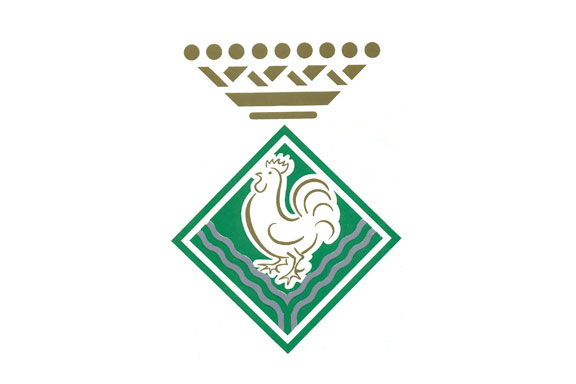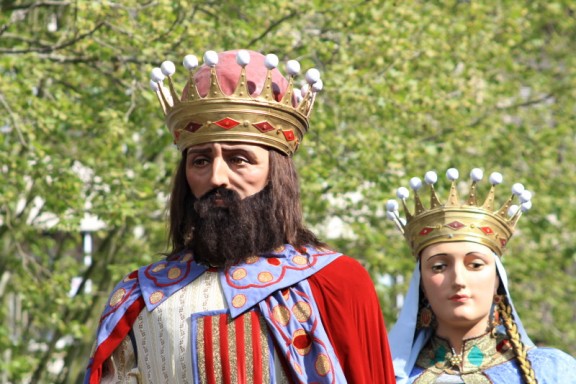Ripoll. Steeped in a long history that gives
sign of identity to Catalonia.
The history has a main characteristic of reminding us about past times, allows us to discover the political, economical, urban and cultural aspects…of a period far away from space and time. However, the historical records and the architectonic heritage are a good way to know the different historical stages in Ripoll.
The origins of this town are closely related to the Count “Guifré el Pelós”, who, as it is said in the legend, created the “senyera”, catalan flag, and the benedictian monastery of “Santa Maria”.
He was very relevant in the history of Catalonia for his political, religious, economic and cultural power. But the personality of our people has also been forged with the work of iron, the production of firearms, internationally known, the associations, the effects of war, the modernism, the railway…
These facts, and others in more modern times, are kept in our collective memory.
The history of the village
The first evidence of human presence in Ripoll is from the Bronze Age (1500-600 BC). We know that there was a little human settlement near the rivers Ter and Freser, and on the mountains that shape the identity of this place. The bronze axes and some dolmens found there give more evidence.
In the IXth century, the inhabitants of this county began to settle at the crossing of the two rivers. It was due to the repopulation of this territory at that time, under the supremacy of the Franks, one of them Guifré el Pelós (840-897). He is considered to be the starter of the Catalan nation. In 879 he founded a romanesque monastery which was administrated by a comunity of monks belonging to the order of Saint Benet, dedicated to Santa Maria. From then on, the monastery improved its facilities; one of the most important works was made in 888, and another one in 1032, the year in which the head of the monastic comunity was Abbot Oliba.
This construction works were closely related to an increase of the political, economic and jurisdictional power of the coenobium in the catalan domain.
The people of Ripoll, seeking security, lived close to the monastery. In the XIVth Century, a wall was built to garantee a safe life for the population, and to resist any possible attack. Soon, a market was established in the village, and a deep channel was built, which took water out from the Freser river. The channel became the economic motive to the village, where the iron, fabrics, wood… were manufactured.
This prosperous period was broken in the year 1428, when an earthquake caused serious damages to the church and other parts of the monastery.
The reconstruction, carried out during the XVth century, implied the adoption of the gothic style when building arches and vaults, but the structure of the oliban church remained untouched. Despite this setback, the growing of the urban nucleous continued, and it began to expand, on the other side of the wall and two neighbourhoods were created. The Abbot Climent Mai built a hospital in the neighbourhoods on the other side of the Ter river. It was founded in 1573.
Even this special respect for the population, during the Modern Age, there were continuous fights between the monastery and the population. The population wanted to break the relations with the Abbot. It didn’t happen, but it diminished his power.
This situation grew worse with the coming of different wars (The War of the Segadors, the presence of the French army in Ripoll, and the War of Succession).
During the XVI-XVIII Centuries, there was an exceptional economic period thanks to trades related to iron industry: blacksmiths, nailsmiths, locksmith, ironmongers, etc.
Of all the industries the most important was firearms. In the manufacturing process three different trades were involved: “encepadors”, who made the stocks, “canonneers”, who made the barrels, and “panyetaires”, who made the bolts, triggers and breech. Ripoll became one of the main manufacturers of firearms in Spain and one of the best in Europe. But not all the population worked with iron; Some people worked with textiles, and some in the chocolate and cereal industries. Life continued until the beginning of the XIXth Century.
During the War of Independence (1808-1814), the French launced frequent attacks on Ripoll causing extensive damage to the city walls. In 1812, the people of Ripoll finally gained independence from the Abbot who had ruled them since the Ixth Century.
The final attack that put an end to the dominion of the monastery and the good economic period was the outbreak of the First Carlist war (1833-1840).
The disentailment promoted by the minister Mendizábal caused the monastical goods to become the state’s property, the abbot and monks abandoned the monastery and the village, and the monastery was plunded and burned by the people who were discontent with the taxes.
This happened in 1835, but the worst moment for the population arrived in May, in 1839, when the commander Charles d’Espagnac attacked the village. After some heavy combats, on the 27th of May the Carlists took control. They burned a great number of houses, bridges and other buildings.
Before 1839 there were 3.200 inhabitants in Ripoll; when the war was over, only one thousand had survived. After the war, some of the inhabitants came back and began to reconstruct their houses by using stones and wood, that in some cases, came from the abandoned buildings of the monastery. Besides, the State sold the monastical outbuildings at auction between the years 1844 – 1850. Apart from these changes, the war meant the frontier from a previous metalurgical activity to a new looking forward to the textil activity.
In the second half of the XIXth Century, the explotation of the water from the rivers Ter and Freser brought the establishment of a large number of factories, headed by people from abroad, who, at the same time, took advantatge of the urbanistic improvements made in the village at this period: The installation of the drinking water network (1882), the street lighting (1892), and the arrival of the railway (1880), due to the necessity to transport to Barcelona the coal from the mines of Ogassa.
These changes brought an increase of the population, who moved to the outskirts, specially in the areas near the railway and the roads leading to other villages.
At this time of economic growth, the monastery of Santa María was restored, thanks to the bishop of Vic, Dr. Josep Morgades, and some families commited to the culture. During the second half of the XIXth Century, there were some works, but it was in 1886 when the reconstruccion was initiated, and it lasted until 1893.
Until the outbreak of the Civil War (1936), Ripoll underwent a great dynamism, as there were some improvings; distinguished modernist buildings are from this period, some of them designed by Joan Rubió, Antoni Gaudí’s colaborateur. The railway network between Ripoll and France was established by means of the “ferrocarril transpirenaico” (railway network in the Pyrinees), inaugurated in 1929.
It is also a good cultural period, as there are many associations, musical bands, theatre companies, chorals, publication of some newspapers, creation of the Sant Pere’s Archive-Museum (1929)…This prosperity encountered its end due to the war and its consequences: the disappearance of any manifestation of catalanity and the imposition of a new political system.
After the hard years of the post-war, Ripoll had another period of progress and expansion. The textil sector recovered and the metal industry experimented an important growth.
This period of welfare state was closely related to an incredible demographic increase, caused mainly by the emigration flows that brought to Ripoll people from all over the Country. In 1950 there were 7.451 inhabitants, whereas in 1970 the population reached the 10.000 inhabitants.
To stand up with this arrival of people, new flats were build in the outskirts of the village, which meant the growing of urban nucleous out of the town. Right after the end of the dictatorship, in the year 1975, the village suffered a series of changes which let to the providing of necessary equipments to face up the XXIth Century.
The toponym and the emblem of Ripoll
One of the first written records of the toponym comes from the year 890, when we hear for the first time the name of “Riopullo” or “riu de pollancres”. The development of the language, throughout the time, would turn the name into “Ripoll”. On the shield of the town, there is a cock making a step to the left. It has under its feet the crossing of the two rivers, Ter and Freser. The green colour represents the mountains round the town.

The giants of Ripoll
In the August of 1945, coinciding with the festivities of “Santa Maria de Ripoll”, the giants were used for the first time. They represent the Count “Guifré el Pelós” and his wife “Guinedell”. They were made in Barcelona, their weight is of 50 Kilos and their height: 3,50 metres.

